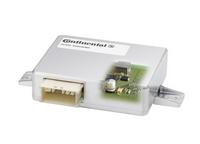Key Component Of Fuel-Efficient Start-Stop Systems Developed By Continental
REGENSBURG, Germany – December 18, 2008: A growing number of vehicles gets equipped with a start-stop function these days: During vehicle standstill with ignition on this feature shuts down the engine without driver activity – typical situations are a wait in front of a red traffic light or at a rail crossing. As soon as the journey can be continued, the driver just needs to step on the clutch, and the engine is re-started immediately. Depending on the driving cycle this feature can improve fuel economy by up to 10 %. Especially on routes with many traffic light stops the fuel saving is so substantial that start-stop systems are right on track to become an in-vehicle standard. However, one phenomenon that occurs during a regular engine start must be avoided with this type of system: As the starting motor consumes a lot of energy, the nominal voltage level of 12 Volt in the electric onboard network can dip as low as 6 Volt. Every driver is familiar with the „side effects“: To supply the starting motor with sufficient energy, the radio is interrupted, ventilation is switched off and the lights are dimmed. If that happened at every traffic light, hardly anybody would accept a start-stop system. Therefore voltage drops must be avoided with this application. DC/DC converters by Continental ensure exactly that: If the voltage in the electric onboard network begins to drop, the DC/DC converter boost this up to a stable 12 Volt (boost converter). Typical available DC/DC converter classes by Continental are 200 Watts or 400 Watts.
Motivated by the attractive fuel efficiency gain, vehicle manufacturers integrate start-stop systems in their existing vehicle architectures. This raises a few issues, however: The DC/DC converter for this feature must not only be highly durable and must tolerate strong temperature changes, it also needs to have a high level of efficiency and it needs to offer ease of integration despite confined installation spaces. When Continental began to develop the DC/DC converter, compact packaging was a top priority from day one in order to simplify vehicle integration. One advantage of the highly efficient DC/DC converters is its little heat loss.
Excellent EMC level – Electromagnetic Compatibility
Owed to their operational principle, all high frequency electronics emit
electromagnetic waves. DC/DC converters are no exception to this. To screen
and contain this emanation the housing of the Continental DC/DC converter
is typically metal. This protects other electronic systems near the boost
converter against cross interferences. This electromagnetic compatibility
(EMC) is relevant because DC/DC converters are typically installed in the
cockpit area in thus in the immediate vicinity of other electronic systems.
During EMC and housing design Continental can draw upon its comprehensive
development and testing expertise stemming from designing control
units.
Effective battery protection with the Intelligent Battery Sensor
IBS
As a start-stop system notably increases the number of engine
start-up processes, the starter battery has to be protected against
depletion. For that purpose a body controller checks the immediate battery
state and will only permit the start-stop function to be active, if the
three main battery parameters, State of Charge (SoH), State of Function
(SoF) and State of Health (SoH), are in line with this. The Intelligent
Battery Sensor IBS by Continental provides these data: The battery sensor
unit can be fully integrated as an intelligent battery cable clamp into the
terminal areas of European standard batteries, and is in production since
2008. The combination of DC/DC converter and IBS provides optimal
conditions for saving fuel: The boost converter increases comfort, the IBS
protects the battery and thus ensures that the vehicle can be started.
With targeted annual sales of €25 billion for 2008, the Continental Corporation is one of the top automotive suppliers worldwide. As a supplier of brake systems, systems and components for the powertrain and chassis, instrumentation, infotainment solutions, vehicle electronics, tires and technical elastomers, the corporation contributes towards enhanced driving safety and protection of the global climate. Continental is also a competent partner in networked automobile communication. Today, the corporation employs approximately 146,500 at nearly 200 locations in 36 countries.
Supplying both, OEMs and the Aftermarket worldwide, the Interior Division of Continental AG develops and produces electronic systems which allow the information in a vehicle to be controlled and communicated according to the requirements of the driver and the driving situation. The Division achieves annual sales of more then € 6 billion (based on 2006 figures) with a workforce of more than 33,000 employees currently. The range of products includes instruments clusters and multifunctional displays, control units, electronic car entry systems, tire information systems, climate control systems, radios, multimedia and navigation systems, telematic solutions as well as cockpit modules and systems. The Interior Division develops vehicle electronics enabling car-to-car and car-to-infrastructure communication, Internet access and the seamless integration of mobile devices (car-to-device). The focus on systems integration offers customers less complexity and ensures efficient and cost-effective solutions for the management of information in passenger cars as well as commercial and special vehicles.



